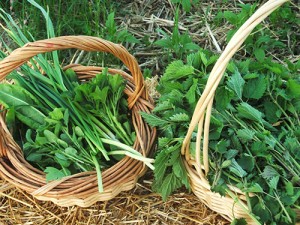When Amber Westfall is out of food, she doesn’t run to the grocery store like everyone else. Instead, she goes to her backyard or a local field to gather wild ingredients.
Westfall, a full-time foraging enthusiast in Ottawa, reduces her grocery bill by eating wild foods she finds.
Foraging is gathering uncultivated food that people often consider weeds. Wild food consists of plants, root vegetables, berries, nuts, and fungi. Foragers look for food in both rural and urban environments.
“I love the idea of going to my backyard to gather the plants that are growing there,” she said. “The other day I was walking and found rose hips on a bush. So, I grabbed a handful for herbal tea.”

Westfall, who teaches herbal medicine on the side at the International Academy Health Education Centre, became obsessed with local and wild food during the hard economic times in 2008. She limited her consumption of imported foods for environmental and economic reasons.
Wild food only comprises a small percentage of her diet. However, Westfall believes the foods affect her overall health and reduce medical costs.
“I think the greatest economic value comes from the fact that wild foods tend to be significantly higher in nutrients and minerals,” she said. “So, even though I am only getting a portion of my diet from wild foods, a significant portion of my nutrient needs are met by wild foods.”
Although she still needs to buy groceries, Westfall saves money on certain produce depending on the season. Plants that Westfall regularly forage include stinging nettle, dandelion leaf and root, garlic mustard, ostrich ferns fiddleheads and violets.
“There is a significant time in the summer where I do not buy any greens because I can gather them outside,” said Westfall.
With frigid Canadian winters, local food becomes expensive and difficult to find in stores. For Westfall, wild foods are a way of accessing local food throughout the year. Wild plants tend to have a longer harvest period, which allows foragers to collect them until the frost.
For the winter, wild ingredients can be jarred, dried, dehydrated, or frozen.
Collecting wild foods can reduce costs year-round, but you have to be committed. Dylan Gordon, a professor at the University of Toronto who specializes in wild food, said people who forage on the side will not see dramatic savings.
“For urbanites who forage, and I think that is a very, very small group, I doubt it makes any impact whatsoever. It’s more like a spice or something interesting to try,” said Gordon. “But, the majority of foraged products, are picked by people who do it professionally. And for them it is an occupation.”
Westfall has made a business out of foraging food in Ottawa. In 2013, she started the Wild Garden where she offers various workshops and expeditions to find wild foods. She also sells her foraged items, ranging from $60 to $80 for three boxes.
Foraging food has become a culinary trend around the world. Matthew Brearley, an executive chef at St. Paul’s University in Ottawa, offers foraged meals to his clients.
He explained if he were to purchase wild food, it would be expensive as this food is rare and requires more labour to harvest.
“But for someone who knows where to get these foods, foraging is quite cost effective,” said Brearley. “Morels [mushrooms] cost around $40 lbs. So, I go out and collect about 20 to 50 lbs. for large cost saving.”
Although foraging food can be challenging, Westfall explained she has never looked back.
“It is one of those things, that whenever I am outside, the weeds that I pull in the garden are the weeds that I bring home for dinner,” said Westfall.
